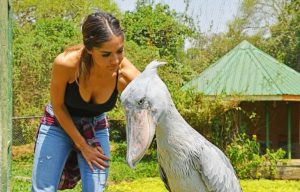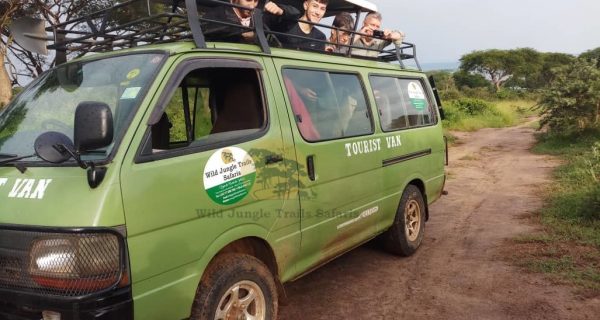Uganda Birding Safaris
Top Uganda Birding Safaris, Bird Watching tours in Uganda, Birding trips Uganda
Uganda birding safaris should be the top choice on any avid travelers bucket list with the birding safaris in Uganda to different destinations all being rewarding. Uganda is a premier Africa birding safari destination, host to over 1,070 bird species habited in forests and savannah grasslands. This is almost half of the total bird species in Africa. Uganda birding safaris are an all year activity that can be planned on either short excursions or long Uganda safaris.
Uganda has 1 endemic bird (not found anywhere else in the world) known as the Fox’s Weaver found in the districts of Kumi and Soroti.

Uganda birding Safaris – Wild Jungle Trails Uganda Safaris
The Shoebill Stork is endemic to Africa and Uganda has a number of them in different spots including Mabamba wetland and Murchison Falls National Park. This is a sought after bird specie and a must see for many bird watching safari Uganda tourists.
The Grey Crowned Crane (Balearica regulorum) is the national bird of Uganda spotted especially in Murchison Falls National Park.
25 bird species are endemic to the Albertine Rift and these include, the Handsome Francolin, Shelley’s Crimson-wing, Rwenzori Turaco, Willard’s Sooty Boubou, Stripe-breasted Tit, Grauer’s Broadbill, Red-throated Alethe, Dwarf Honeyguide, Black-faced Apalis, Rwenzori Apalis, Grauer’s Swamp Warbler, Grauer’s Warbler, Neumann’s Warbler, Red-faced Woodland Warbler, Yellow-eyed Black Flycatcher, Rwenzori Batis, Purple-breasted Sunbird, Regal Sunbird, Stuhlmann’s Sunbird, Strange Weaver, Dusky Crimson-wing, Archer’s Robin-chat, Blue-headed Sunbird, Yellow-crested Helmet Shrike and African Green Broadbill.
Other birds that can be spotted in the boundaries of Uganda include; Marabou storks, Doherty’s Bushshrike, Saddle-billed Stork, Green-Breasted Pitta, Standard-Winged Nightjar, Black Breasted Barbet, Bar-tailed Trogon, African Spoonbill, Yellow-billed Oxpecker, Long Crested Eagle, Black Bee-Eater, Chocolate Backed Kingfisher, White-faced whistling-duck, Fulvous whistling-duck, White-backed duck, Knob-billed duck, Egyptian goose, Helmeted guineafowl, Vulturine guineafowl, crested guineafowl, stone partridge, Nahan’s Francolin, Scaly Francolin, Crested Francolin, Rock pigeon, Namaqua dove, Bruce’s green-pigeon, African green-pigeon, Karamoja Apalis and many more.
More important information to know about Uganda Birding Safaris
Best bird watching spots in Uganda
Uganda has birds throughout the country however, there those top spot with high bird populations that a birder should have on their itinerary and these include;
- Queen Elizabeth National Park – has over 600 bird species, the biggest population of all Uganda safari parks.
- Bwindi Impenetrable National Park – home to 23 of the 24 Albertine Rift endemic bird species.
- Murchison Falls National Park – home to most of the savannah bird species in Uganda.
- Mabamba wetland – closest place to spot the Shoebill Stork from Entebbe International Airport
- Kidepo Valley National Park-Has over 470 bird species with 60 of them not recorded anywhere else in the world.
What to carry for Uganda birding safaris
Packing for a trip is as important as booking your dream safari, to pack for a Uganda birding safari always remember to include these on top of your wish list;
- A field guide book or tablet with bird list and details
- Carry good quality binoculars and other critical accessories
- Pack your camera, batteries, memory card and its cleaning equipments
- Carry a small field bag or back pack
- Pack necessary field clothing including long trousers and shirts
- Carry the right foot wear
- Pack insect repellent and sunscreen
Best time for Uganda birding safaris
Though Uganda bird watching tours can be undertaken year round, the best time for birding safaris in Uganda is during the dry season from late May to September. The factor that affects trips most is the weather and climate and Uganda as a country has 2 seasons in the south, the dry season being June –August and December – February and the rainy season March –May and September – November. To the north, late March – early November is the wet season and November – March being the rainy season. None of these weather conditions is extreme and birding safaris can be done any time.
However, if planning to visit any specific spot, remember to check out the best time for birding in that specific park or bird watching site.

